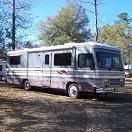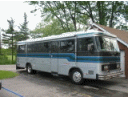Go to...  | Start A New Topic  | Search  | Notify  | Tools  | Reply To This Topic  |  |
Just wondering if anyone would happen to have a brochure of 92' 30' Breakaway? Thanks ------------------ Bruce | |||
|
"First Year of Inception" Membership Club |
I do not have a brochure, but I have the build specs as well as several ads for the 1992 Breakaway. I have emailed them all to you. ------------------   | |||
|
Bruce & Dave, I have what appears to be a sales brochure (color),a spec sheet and a price list for the 92 Breakaway (28 and 30"). A note with it is dated May 92 so I assume it is the 92 model. I have a similar set for the Regency (32 to 40'). I can scan any or all that Dave doesn't have for the archives. Stu | ||||
|
That would be great. What I am looking for is tank sizes, fresh water, gray & black holding tanks & fuel and LPG. | ||||
|
Capacities: Fresh water - 44 gal. Holding - Dual - 66 gal. Fuel tank - 60 gal. LP Tank - 25 gal. | ||||
|
 |
Good morning, Dave: Being the proud new owners of a 1992 30' Breakaway, we sure would like to have copies of these. Email is fine. bferen@yahoo.com Thank you for all you do.
Betsy & Carl Feren Ms Idgie and April 1992 30' Barth Breakaway | |||
|
Stu, I have a 1990 Regency with the cat engine, what is the fresh water capicity, and black and grey cap.. Thanks Sky 1990 Barth Regency 32RDGB1 Wide Body 3208 Cat 250 HP Gillig Chassis Center aisle | ||||
|
Captain Doom |
One can't always depend on the brochures - my 28' Breakaway erection diagram, which should be more accurate than the brochures, lists 60 gal. fuel, and 60 gal. water. Fuel is 40 gal. and water is also (although I haven't yet measured the tank). Rusty '94 28' Breakaway: MilSpec AMG 6.5L TD 230HP Nelson and Chester, not-spoiled Golden Retrievers Sometimes I think we're alone in the universe, and sometimes I think we're not. In either case the idea is quite staggering. - Arthur C. Clarke It was a woman who drove me to drink, and I've been searching thirty years to find her and thank her - W. C. Fields | |||
|
Sky, The only specs I locate now for the Regency are dated 1994 so may not fit yours but here goes: Fresh water - 100 gal. on 36-40 footers, 76 gal. on 32-34 ft.,Holding tank shows 100 gal. on 36-40 footers and 80 gal. on 32-34 and doesn't show the split of gray to black. On the 96 Regency the split was 60/40 gray/black on the 100 gal. and 40/40 on the 80 gal. jobs. Hope this helps. Stu Allen | ||||
|
 4/09 4/09Founder and Moderator Emeritus  |
Hi Betsy, they are on the way, I see you have yahoo I hope you get them they are medium sized files.  | |||
|
Dave, Considering 1992 front entry 30" Breakaway. Any tech data would be great. Is there going to be a problem finding the necessary fuel for the Cummins 6BTA engine? An ad can be seen at www.MotorHomesForSale.com ad number 4804 Thanks bill steele steele622@gmail.com | ||||
|
 |
Ron spent several hours showing us this coach a few months ago. It is a beauty! He built a garage to store it indoors. We would have taken it if the 90 Regency hadn't come along for a little less money. I really think you won't go wrong with this one given that it is 15 years old but in Ron's care at least it has been kept in wonderful shape. Don 1990 Regency 34' Cummins 6CTA 8.3 240hp Spartan Chassis, 4 speed Allison MT643 | |||
|
There is no problem with finding fuel for this coach. We have a 92' Breakaway with the same engine and we just fill it up at any service station that sells fuel and have not had any problems. We have it in the shop right now and want them to check if there are any issues with regard since we have been using the low sulfur fuel. Hopefully we'll have her back in a few days. Bruce Nalder Renton, WA. 92-30'Breakaway | ||||
|
There is sometimes a misconception with regard to the low sulfur fuel, and wikipedia has a pretty good explanation, part is excerpted here: Sulfur is not a lubricant, however the process used to reduce the Sulfur also reduces the fuel's lubricating properties. Lubricity is a measure of the fuel's ability to lubricate and protect the various parts of the engine's fuel injection system from wear. The processing required to reduce sulfur to 15 ppm also removes naturally-occurring lubricity agents in diesel fuel. To manage this change ASTM International (formerly the American Society for Testing and Materials) adopted the lubricity specification defined in ASTM D975 for all diesel fuels and this standard went into effect January 1, 2005. [4] The refining process that removes the sulfur also reduces the aromatic content and density of the fuel, resulting in a minor decrease in the energy content, by about 1%. This decrease in energy content may result in reduced peak power and fuel economy. The reduction is only slight and will likely go unnoticed. ULSD will run in any engine designed for the ASTM D-975 diesel fuels. This low sulfur fuel has been in use in Europe for many years and diesel technology in European vehicles is far ahead of U.S. Now that the low sulfur fuel is in use here, we can expect to see many new diesel products that will be able to use the fuel delivery and emissions control technology. Older diesel engines will run on the new fuel and the older mechanical style fuel injection systems on these engines are "lubricated" by the crankcase oil. Where problems have been most evident are with engines that have some form of electronic, and or common rail injection systems that rely to some extent on the "fuel" for some of the lubrication. The lower lubricity of the low sulfur fuel has been suspected as contributing to "premature" injection pump failures but so many factors can come into play that it would be hard to make a hard and fast claim that low sulfur fuel equals pump failure. There are additives that can be substituted that will provide addtional lubrication to these parts. The Cummins, CAT and Detroit diesel engines during the 90's, I believe, are of the mechanical injection variety but it might be good to check a particular engine to see if it's fuel system relies on fuel for lubrication and take appropriate precautions if it does. 1983 Mercedes 300 SD Turbo Diesel... ...Rudolph Diesel ran his first one on peanut oil, I use soybean in mine. Looking for a nice Breakaway. | ||||
|
Captain Doom |
Like much on Wikipedia, the post doesn't tell all. Stanadyne pumps generally use fuel as a lubricant, and it recommends additives to compensate for the reduced "lubricity". ("Lubricity", by the way, is a term we lube guys throw around liberally, but it actually has no definition). Removing aromatic content don't mean diddly - as "aromatics" aren't specifically high-energy-content ends. If the post had read, "removal of longer-chain hydrocarbons", it would be palatable. Denser ends have more energy, but they don't have to be aromatic...but then again, aromatics tend to attract contaminants, and they might be the denser chains. Cat and Cummins use HP injector pumps; DD, OTOH, on its older engines used LP rails and the injector was operated by a cam. In summary, it's safe to assume only that all injector systems rely on the fuel for some lubrication, and additives are a way to compensate for the loss of "lubricity". Somewhere I heard that "Oil's cheaper than metal". Somewhere. Rusty '94 28' Breakaway: MilSpec AMG 6.5L TD 230HP Nelson and Chester, not-spoiled Golden Retrievers Sometimes I think we're alone in the universe, and sometimes I think we're not. In either case the idea is quite staggering. - Arthur C. Clarke It was a woman who drove me to drink, and I've been searching thirty years to find her and thank her - W. C. Fields | |||
|
| Powered by Social Strata |
| Please Wait. Your request is being processed... |
|
This website is dedicated to the Barth Custom Coach, their owners and those who admire this American made, quality crafted, motor coach.
We are committed to the history, preservation and restoration of the Barth Custom Coach.
We are committed to the history, preservation and restoration of the Barth Custom Coach.